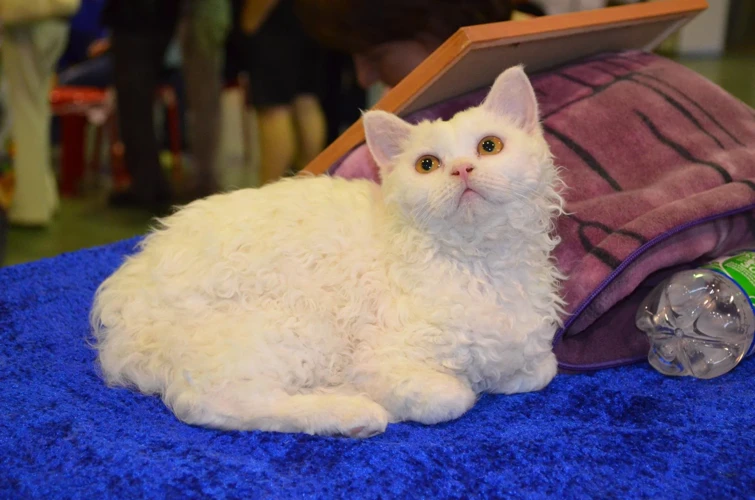Have you recently adopted a California Spangled and are struggling to teach them new commands? It can be a challenge, but with the right methods and approach, your furry friend can quickly learn new tricks. Positive reinforcement techniques have proven to be the most effective and humane way to teach your California Spangled new commands. In this article, you’ll discover five positive reinforcement methods that will help you train your California Spangled and strengthen your bond in the process. From clicker training to socialization, we’ll cover everything you need to know to transform your cat into a well-trained and obedient pet. So, let’s dive in and explore the world of positive cat training!
Method 1: Clicker Training

Clicker training is a useful positive reinforcement method for teaching new commands to your California Spangled. This technique is based on rewarding your feline friend for performing the correct behavior. Clicker training can be especially helpful for cats who are motivated by treats and toys. Using a clicker can help signal your California Spangled that they have performed the desired behavior correctly. In the following sections, we will explore the benefits of clicker training and give you tips on how to use this technique to train your cat. If you want to learn more about positive reinforcement training for California Spangled cats, check out our article “Positive Reinforcement Training for California Spangled.”
What is Clicker Training?
Clicker training is a powerful and effective method of positive reinforcement for teaching California Spangled new commands. This method involves using a small handheld device that makes a clicking sound when pressed, followed by a treat or other reward for the cat. The clicking sound serves as a signal that the cat has performed the desired behavior, and the treat serves as a reward for that behavior.
Some key benefits of clicker training for California Spangled are:
- Clear communication: Clicker training provides a clear and consistent communication method between the owner and the cat. The sound of the clicker lets the cat know immediately when they have done something right, which helps to eliminate any confusion or uncertainty.
- Rewards-based: Clicker training is a positive reinforcement method, which means that it is based on rewards rather than punishment. This helps to build a positive relationship between the cat and the owner, and encourages the cat to be more receptive to new commands.
- Efficient: Clicker training can be a very efficient way to teach new commands to California Spangled. With consistent and frequent training sessions, cats can quickly learn new behaviors and commands.
Clicker training requires some preparation and a bit of patience, but it can be a very effective way to train your California Spangled. Start by getting a clicker and some treats that your cat loves. Then, follow these steps:
- Begin by clicking the clicker and immediately giving the cat a treat. Repeat this several times, so that the cat begins to associate the clicking sound with a reward.
- Wait until your California Spangled performs a desired behavior, such as sitting or coming when called. As soon as the cat performs the behavior, click the clicker and give the cat a treat.
- Repeat this process several times, so that the cat begins to understand that the clicker sound means they have done something right. gradually try to move away from giving out treats and make the cat respond only to the sound of the clicker.
- Over time, gradually increase the difficulty of the behaviors you ask the cat to perform. As your California Spangled masters each behavior, continue to reinforce it with the clicker and treats.
If you want to learn more about positive reinforcement methods for training your California Spangled, you can follow this link: Positive Reinforcement vs Punishment for California Spangled.
How to Use Clicker Training
To use clicker training for teaching your California Spangled new commands, follow these steps:
- First, get a clicker and some treats that your cat loves. Clickers can be found in most pet stores or online, and any small, bite-sized treat will work.
- Next, choose a command that you want to teach your California Spangled, such as ‘sit’ or ‘come.’
- Wait for your cat to naturally do what you want to train them to do, such as sitting down.
- As soon as your cat performs the desired action, click the clicker and give them a treat. This should be done quickly, as you want your cat to understand that the clicker sound means a reward is coming.
- Repeat the process several times until your California Spangled understand that when they hear the clicker sound, they are going to receive a treat.
- Once they have learned this association, you can start using the clicker to train your cat to perform the desired command.
- For example, say ‘sit’ and wait for your cat to sit down. As soon as they do, click the clicker and give them a treat. Repeat until your cat associates the word ‘sit’ with the action of sitting down.
Using a clicker for training your California Spangled has several advantages. Firstly, it allows you to reinforce good behavior as soon as it occurs, which makes it easier for your cat to learn. Secondly, it gives your cat a clear signal that a reward is coming, which encourages them to repeat the behavior. Lastly, using a clicker helps to eliminate any confusion or misunderstanding between you and your cat during the training process.
If you want to learn more about the benefits of positive reinforcement training versus punishment, check out our article on positive reinforcement versus punishment for California Spangled. And if you want to learn more about the specifics of clicker training, see our article on clicker training for California Spangled.
Why Clicker Training Works for California Spangled
Clicker training is a powerful tool for teaching commands to California Spangled because it allows for clear communication between owner and cat. By using a click as a marker for desired behavior, the cat is able to learn exactly what they are doing correctly. This precise reinforcement is especially effective for California Spangled, who are known for their intelligence and problem-solving abilities.
Additionally, clicker training allows for positive reinforcement without the need for physical touch or treats. This can be especially helpful for timid or food-motivated cats. The clicker itself becomes a powerful signal of praise, leading to increased confidence and a positive association with learning new commands.
Another reason why clicker training is so effective for California Spangled is that it can be used in a variety of environments. Whether training at home, in a park, or on a trip, the clicker can be used consistently to reinforce positive behavior and new commands.
Clicker training is particularly useful for training California Spangled due to their intelligence, problem-solving abilities, and need for clear communication. By using a clicker in combination with positive reinforcement, owners can effectively train their cats to learn new commands in a low-stress, confidence-building environment.
Method 2: Treats and Rewards

When it comes to training your California Spangled, positive reinforcement is key. One of the most effective methods of positive reinforcement is to use treats and rewards. By giving your cat a tasty treat or rewarding them with playtime, you can encourage them to learn new commands and behaviors. In this section, we will explore how to use this method effectively and what types of treats and rewards work best for your California Spangled. Let’s dive in and discover the power of positive reinforcement through treats and rewards.
How to Use Treats and Rewards
When it comes to using treats and rewards for teaching new commands to your California Spangled, there are a few key points to keep in mind. By following these steps, you can encourage positive behavior and reinforce good habits in your cat.
Firstly, it’s important to use the right timing. When your cat performs a desired behavior, give them a small treat or reward immediately afterward. This will help your cat learn to associate the behavior with the reward, which will encourage them to repeat the action in the future. Remember, the key is to reinforce good behavior as soon as it happens.
Secondly, choose your treats carefully. Not all treats are created equal. Avoid using treats that are high in calories or sugar, which can lead to weight gain and other health problems. Instead, opt for small, natural treats that are easy to digest and won’t upset your cat’s stomach. Some good options include small pieces of cooked chicken or turkey, freeze-dried meat treats, or even plain kibble.
Thirdly, be consistent in your use of treats and rewards. Use the same treat each time your cat performs the desired behavior, and give the reward in the same way each time. This will help your cat learn to associate the behavior with the reward, and make it easier for them to understand what you’re asking of them.
Lastly, use positive reinforcement techniques in conjunction with your treats and rewards. When your cat performs the desired behavior, give them verbal praise and affectionate pets. This will help reinforce the behavior and encourage them to continue doing it in the future.
Using treats and rewards can be an effective way to teach new commands to your California Spangled. By following these tips and using positive reinforcement techniques, you can help create a happy and well-behaved feline companion.
| What to do: | What not to do: |
|---|---|
| Use the right timing: Give the treat or reward immediately after the desired behavior occurs. | Don’t wait too long to give the treat or reward, or your cat may not understand what they’re being rewarded for. |
| Choose your treats carefully: Opt for small, natural, and easy-to-digest treats to avoid health problems. | Don’t use treats that are high in sugar or calories, or you may run the risk of causing health issues in your cat. |
| Be consistent: Use the same treat and give the reward in the same way each time. | Don’t change the type of treat or the way you give the reward, or your cat may become confused. |
| Use positive reinforcement techniques: Give verbal praise and affectionate pets in conjunction with the treat and reward. | Don’t withhold positive reinforcement, or your cat may not understand why they’re being rewarded. |
The Best Treats for California Spangled
When it comes to using treats as positive reinforcement for teaching new commands to your California Spangled, it’s important to choose ones that are tasty, healthy, and easy for them to consume. Here are some of the best treats to give your feline friend:
| Treat Type | Why it’s Great |
|---|---|
| Freeze-dried meat treats | These treats are made of pure meat, making them high in protein and low in carbohydrates. They’re also low in calories, ensuring your California Spangled doesn’t pack on the pounds while being rewarded. |
| Catnip-flavored treats | For cats that love catnip, these treats are a great way to motivate them. They often come in fun shapes and sizes and are great for training and playtime. |
| Soft and chewy treats | These treats are easy to break apart and are perfect for training sessions that require multiple treats. They come in a variety of flavors and are often enriched with vitamins and minerals. |
| Cat grass | While not technically a treat, cat grass is a great option for cats that enjoy nibbling on greens. It can be used to reinforce positive behavior and also aids in digestion and promotes fresh breath. |
Before introducing any new treats into your California Spangled’s diet, be sure to check with your veterinarian to ensure they are safe and appropriate for your cat’s dietary needs. Remember to also use treats in moderation and balance them with plenty of playtime and affection to ensure your feline companion remains happy and healthy.
Why Treats and Rewards Work for California Spangled
California Spangled cats are intelligent and curious creatures, making them receptive to positive reinforcement training methods. Treats and rewards are effective ways to train California Spangled cats for new commands because they associate the behavior with a positive outcome.
When a California Spangled cat performs the desired behavior, treats and rewards give them a sense of accomplishment. The cat can recognize that they did a good job, which encourages them to repeat the behavior again. Treats and rewards can also create a bond between the trainer and the cat, as the cat learns to associate the trainer with positive experiences.
Using treats and rewards for command training with California Spangled cats can also help keep the training sessions fun and enjoyable. A positive training environment can help ease any stress or anxiety that the cat may feel during training.
However, owners should be careful not to overfeed their California Spangled cat or use treats that are high in calories. It is recommended that the treat size should be small and that the overall calorie intake of the cat should be monitored.
Here’s a table of the best treats for California Spangled cats during training:
| Treat | Description |
| — | — |
| Freeze-dried chicken | High in protein and easy to break into small pieces |
| Tuna | High in protein and omega-3 fatty acids |
| Catnip treats | A favorite of many cats, can increase playfulness and motivation |
| Natural, grain-free cat treats | Healthy and low-calorie option |
| Cooked, shredded chicken | Homemade option and cost-effective |
Using treats and rewards should be paired with positive reinforcement language and tone to create a productive training session with your California Spangled cat.
Method 3: Positive Voice Commands

When it comes to teaching new commands to your California Spangled, positive voice commands can be a powerful tool in your arsenal. Communicating with your feline friend through positive reinforcement techniques can help them understand what you expect from them, instilling good behavior and strengthening your relationship with them. Let’s explore this method in greater detail, and discover how you can use positive voice commands to help your California Spangled become a well-behaved and obedient companion.
How to Use Positive Voice Commands
When using positive voice commands to teach new commands to your California Spangled, it’s important to keep a few key things in mind:
1. Keep the tone of your voice consistent: Consistency is key when it comes to using positive voice commands. Use the same tone of voice every time you give a command so that your cat can easily recognize when you’re giving them a command.
2. Make sure your cat is paying attention: Before giving a command, make sure your cat is paying attention to you. If they’re distracted or not paying attention, they may not respond to your commands.
3. Use short and simple commands: Keep your commands short and simple. Using longer or more complex commands can confuse your cat and make it more difficult for them to understand what you want them to do.
4. Reward good behavior: Positive voice commands work best when they’re paired with rewards for good behavior. Whenever your cat successfully completes a command, give them a treat or some extra playtime to reinforce the behavior.
Here are some steps to follow when using positive voice commands to teach new commands to your California Spangled:
- Choose a command that you want to teach your cat, such as “sit” or “stay”.
- Get your cat’s attention and use their name to make sure they’re focused on you.
- Use a clear and concise voice command, such as “sit”.
- If your cat successfully completes the command, reward them with a treat or some extra playtime.
- Repeat the command and reward the behavior until your cat has learned the command.
- Once your cat has learned the command, you can begin to phase out the treats and rewards, but continue to use positive voice commands to reinforce good behavior.
By following these steps and using consistent positive voice commands, you can effectively teach your California Spangled new commands. Remember to be patient and consistent, and always reward good behavior to reinforce the training.
The Best Voice Commands for California Spangled
Using positive voice commands can be an effective way to teach your California Spangled new commands. However, it’s important to use the right language to ensure your cat understands what you are asking of them. Here are some of the best voice commands to use for California Spangled command training:
| Voice Command | Description |
|---|---|
| “Come” | Calls your cat to come to you. |
| “Stay” | Encourages your cat to stay put until released. |
| “Sit” | Orders your cat to sit down. |
| “Down” | Instructs your cat to lay down on the ground. |
| “Jump” | Tells your cat to jump onto or over an object. |
| “Fetch” | Encourages your cat to retrieve an object and bring it back to you. |
| “Leave it” | Tells your cat to stop whatever they are doing or to leave a certain object alone. |
Remember to use a clear and commanding tone when using these voice commands. It’s also important to consistently use the same words for each command to avoid confusion. Practice these voice commands during your training sessions to help reinforce your California Spangled’s understanding of the commands.
Why Positive Voice Commands Work for California Spangled
Using positive voice commands is an effective method for teaching new commands to your California Spangled. Here are some reasons why:
- Encourages Bonding: When you use positive voice commands, you are creating a positive association between you and your cat. This encourages a strong bond between the two of you and makes your cat more responsive to your commands.
- Creates a Positive Environment: Positive voice commands create a happy and positive environment for your California Spangled, which makes them more eager to learn and respond to training.
- Builds Confidence: By using positive reinforcement, you are building your cat’s confidence every time they successfully follow a command. This confidence can translate into other areas of their life, making them more independent and self-assured.
- Avoids Fear and Aggression: Using negative commands or punishment can lead to fear and aggression in cats. Positive voice commands avoid this negative response and keep your cat calm and receptive to training.
- More Effective: Research has shown that positive reinforcement techniques, such as positive voice commands, are more effective for teaching new commands to pets. This is because the approach is based on encouragement and reward, which motivates your California Spangled to want to learn and succeed.
By using positive voice commands, you are creating a safe and loving environment for your California Spangled to learn and grow. This method is a great way to teach new commands, build a strong bond, and encourage confidence in your furry friend.
Method 4: Playtime

Teaching new commands to your California Spangled can be a challenging but rewarding experience. One method that can help make the training process fun for both you and your feline friend is incorporating playtime. Playtime provides an opportunity to bond with your cat while reinforcing positive behaviors. By utilizing the right toys and techniques, you can turn playtime into a valuable training tool. Let’s explore how to use playtime for effective command training.
How to Use Playtime for Command Training
One of the most effective ways to teach new commands to your California Spangled is through playtime. Incorporating play into your training can help you establish a strong bond with your feline friend, making it easier for them to learn new commands while having fun. Here are some tips on how to effectively use playtime for command training:
- Start with short sessions: Begin with short playtime sessions of about 10-15 minutes, gradually increasing the duration as your California Spangled becomes more comfortable with the training.
- Use toys: Utilize interactive toys like cat wands, toy mice, balls, and catnip-stuffed toys to encourage activity and engagement.
- Incorporate commands: During playtime, use simple commands like “come” or “fetch” and wait for your cat to respond before tossing a toy or offering a reward.
- Mix it up: Incorporate both skill-building activities like agility training and more low-key activities like chasing a laser pointer to keep your California Spangled engaged and stimulated.
- Make it a routine: Incorporate playtime into your cat’s daily routine, ideally at the same time every day, so it becomes something they look forward to and anticipate.
By using playtime as an interactive training technique, you can help your California Spangled learn new commands, improve their agility, and keep them active and healthy. Remember to keep training sessions short, incorporate rewards and cues, use a variety of toys, and make it fun and engaging for both you and your furry friend.
The Best Toys for California Spangled
When it comes to using playtime as a positive reinforcement method for teaching new commands to your California Spangled, choosing the right toys is essential. Not only should the toys be engaging and exciting for your cat, but they should also be safe and durable enough to withstand hours of play.
Here are some of the best toys for California Spangled to use during command training:
- Interactive toys: Interactive toys such as puzzle feeders or treat balls can be great for command training as they engage your cat’s mind and encourage problem-solving skills.
- Wand toys: Wand toys are great for playing with your cat and can be used to teach commands such as “jump” or “follow” as you move the toy around.
- Balls: California Spangled cats love to play with balls, especially ones that make noise or have a texture that they find interesting.
- Feather toys: Feather toys are a classic favorite among cats, and can be used to teach commands such as “catch” or “jump”.
- Catnip toys: Catnip toys can be a great way to keep your cat engaged and excited during playtime, making them more receptive to learning new commands.
Remember to always supervise your cat during playtime and choose toys that are appropriate for their age and energy level. By incorporating playtime and the right toys into command training, you can create a fun and positive learning experience for your California Spangled.
Why Playtime Works for California Spangled
Playtime is an important aspect of command training for California Spangled cats. It works as a positive reinforcement method by creating a fun and engaging environment where your cat can learn and practice new commands.
During playtime, you can incorporate command training by using toys and games that require your cat to perform certain actions, such as chasing a toy or jumping through a hoop. As your California Spangled begins to understand and follow these commands, they can be rewarded with treats or praise.
One of the reasons why playtime works so well for California Spangled cats is their natural athleticism and curiosity. These cats are known for their love of physical activity and exploring new environments. By incorporating playtime into command training, you can tap into these instincts and make learning new commands an enjoyable experience for your cat.
Another benefit of playtime is that it helps to strengthen the bond between you and your California Spangled. By spending time engaging in fun and stimulating activities together, you develop a deeper connection that can further enhance their motivation to learn and follow commands.
| Reasons Playtime Works for California Spangled |
|---|
| Creates a fun and engaging environment for command training |
| Taps into natural athleticism and curiosity |
| Strengthens bond between owner and cat |
By incorporating playtime as a positive reinforcement method for command training, you can make the process more enjoyable and effective for your California Spangled. With consistent practice and patience, you’ll see your cat become more responsive to your commands, paving the way for a happy and well-trained feline companion.
Method 5: Socialization
As social creatures, California Spangled cats are highly adaptable to their environment and the people who surround them. Thus, socialization is a crucial aspect of their development. It is important to expose them to a variety of positive experiences from an early age, as this will shape their behavior and outlook in life. In this segment, we will explore the different ways in which socialization can be used as a positive reinforcement method to teach new commands to your California Spangled. Let’s dive into the details and learn some effective socialization techniques.
How to Socialize your California Spangled for Command Training
Socialization is a crucial aspect of training your California Spangled for new commands. It involves introducing your cat to new people, animals, and environments, which helps them adapt to different situations more easily. Here are some steps you can take to socialize your cat for command training:
| Step | Description |
|---|---|
| Step 1: Start Early | The earlier you start socializing your California Spangled, the better. Kittens are more open to new experiences and less fearful than adult cats. Start by exposing your kitten to different people, sounds, and environments in a positive way. |
| Step 2: Use Positive Reinforcement | Associate new experiences with positive things like treats, playtime, and affection. This will create positive associations and make your cat more willing to try new things. |
| Step 3: Introduce Gradually | Expose your cat to new things gradually. For example, if you want to introduce them to other animals, start with a calm and friendly dog or cat and gradually increase the exposure as your cat becomes more comfortable. |
| Step 4: Supervise Interactions | Always supervise your cat’s interactions with new people, animals, or environments. This will ensure their safety and prevent any negative experiences that could hinder their socialization progress. |
| Step 5: Remain Calm | Cats can sense when their owners are nervous or anxious, which can make them feel uneasy. Remain calm and relaxed during socialization sessions to encourage your cat to be calm as well. |
These socialization steps can help your California Spangled become comfortable with new people, animals, and environments. This will make command training easier and more effective as your cat will be more willing to learn in different situations. Remember to always use positive reinforcement and patience during the socialization process to create a positive association with training.
The Best Socialization Techniques for California Spangled
To effectively socialize your California Spangled, there are several techniques you can use. These techniques will not only prepare your cat for learning new commands but also improve their overall behavior and confidence.
Technique 1: Exposure to new people and pets
This technique involves gradually introducing your California Spangled to new people and pets. Start with short and controlled interactions, such as inviting one or two people over, and gradually increase the number of visitors. You can also introduce your cat to friendly and well-behaved pets to help them learn to socialize better.
Technique 2: Positive reinforcement
The goal of this technique is to get your cat to associate new experiences with positive feelings. When your California Spangled interacts with new people or pets, reward them with treats or praise. This encourages them to approach new situations with a positive attitude.
Technique 3: Exposure to new environments
Introduce your California Spangled to new environments to help them become more adaptable to changes. Start with a quiet and familiar location, like your home. Once they become comfortable with the new environment, gradually expose them to new and stimulating locations, like parks or cafes.
Technique 4: Desensitization
Desensitization is a technique used to reduce the fear or anxiety your California Spangled may have towards certain objects or situations. Start by exposing your cat to the fearful object or situation at a distance, and then gradually move them closer as they become more comfortable.
Technique 5: Social playtime
Having a regular playtime with other cats or pets can help your California Spangled learn essential social skills. Encourage your cat to interact with toys and playmates in a positive and friendly manner.
Using a combination of these socialization techniques will help your California Spangled become more confident and comfortable in various settings. Remember to always reward positive behavior and be patient with your cat’s progress.
| Technique | Description |
|---|---|
| Exposure to new people and pets | Gradually introduce your cat to new people and pets to help them socialize better. |
| Positive reinforcement | Reward your cat with treats or praise when they interact with new people or pets to encourage positive associations. |
| Exposure to new environments | Introduce your cat to new locations to help them become adaptable to changes. |
| Desensitization | Gradually expose your cat to fearful objects or situations to reduce anxiety and fear. |
| Social playtime | Encourage your cat to interact positively with other cats or pets during playtime. |
Why Socialization Works for California Spangled
Socialization is a critical aspect of training your California Spangled, and it works for several reasons. When you introduce your cat to new people and other animals, they learn to distinguish between different faces, smells, and sounds. This exposure helps them feel comfortable in new situations and environments, which can be beneficial in many ways. Below are some of the reasons why socialization is crucial for California Spangled training:
| Reasons Why Socialization is Important for California Spangled Training |
|---|
| Helps prevent fear and aggression towards strangers and other animals |
| Teaches them to interact appropriately with other people and animals |
| Reduces stress and anxiety in unfamiliar situations |
| Increases their confidence when faced with new challenges |
| Creates a bond of trust between owner and cat |
Socializing your California Spangled is not just about training them to follow commands but also about ensuring that they have a positive experience in the world around them. Proper socialization can help prevent unwanted behaviors such as fear, aggression, and anxiety, which can negatively impact your cat’s quality of life. Socialization is a crucial part of training your California Spangled, and it offers numerous benefits that will help improve your cat’s overall well-being.
Conclusion
In conclusion, teaching new commands to your California Spangled can be an enjoyable and rewarding experience for both you and your furry friend. By employing positive reinforcement methods such as clicker training, treats and rewards, positive voice commands, playtime, and socialization, you can effectively teach your cat new commands while strengthening your bond with them.
It’s important to remember that every cat is unique and may respond better to certain methods over others. Therefore, it’s crucial to experiment with different methods and tailor your approach to your cat’s personality and learning style. Consistency and patience are key, and it’s crucial to avoid punishment or negative reinforcement, as this can damage the trust and relationship between you and your cat.
By using positive reinforcement, you can create a fun and stimulating training environment that focuses on rewarding desired behavior, rather than punishing unwanted behavior. Remember to always keep training sessions short and focused, and to end each session on a positive note. With dedication, patience, and consistency, you can train your California Spangled to understand and follow a range of commands, from sit and stay to come and play. So start training today, and enjoy the many benefits of a well-trained and happy kitty.
Frequently Asked Questions
Can California Spangled cats learn new commands?
Yes, California Spangled cats are highly intelligent and can learn new commands with the right training methods.
What kind of training methods work best for California Spangled cats?
Positive reinforcement methods work best for California Spangled cats. Clicker training, treats and rewards, positive voice commands, playtime, and socialization are all effective methods.
What is clicker training?
Clicker training is a training method that uses a clicker to mark desired behavior, followed by a treat or reward, to reinforce that behavior.
How do I use clicker training to teach my California Spangled new commands?
Start by associating the clicker sound with a treat or reward. Then, use the clicker to mark desired behavior and follow up with a treat or reward. Repeat this process consistently until the California Spangled learns to associate the clicker sound with the desired behavior.
What treats are best for California Spangled cats during training?
Treats that are moist, soft, and small in size work best for California Spangled cats. Treats made of salmon, chicken, or turkey are usually the most appealing to cats.
What are positive voice commands?
Positive voice commands are verbal cues that encourage desired behavior. For example, saying “good kitty” when the California Spangled responds correctly to a command reinforces that behavior.
How do I socialize my California Spangled for command training?
Socializing your California Spangled involves exposing them to different environments, people, and animals to build their confidence and decrease their anxiety. This will make it easier for them to learn new commands.
What kind of toys should I use during playtime for command training?
Toys that stimulate the California Spangled’s natural instincts, such as toys that mimic prey, work best during playtime for command training. For example, using a feather wand toy can help teach the “jump” command.
What are some of the best positive reinforcement methods for teaching my California Spangled new commands?
Clicker training, treats and rewards, positive voice commands, playtime, and socialization are all effective positive reinforcement methods for teaching your California Spangled new commands.
Can California Spangled cats learn commands as well as dogs?
Yes, California Spangled cats are highly intelligent and can learn commands just as well as dogs with the right training methods.







